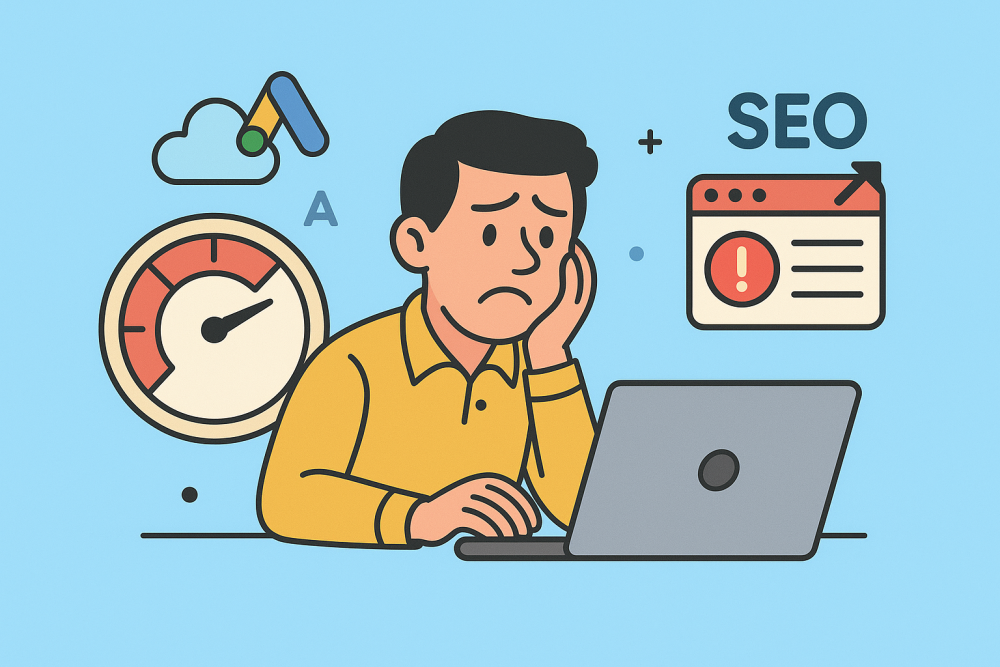
A slow website doesn’t just frustrate visitors—it can also destroy your Google Ads campaigns, hurt your SEO rankings, and ultimately cost your business real money. In this article, we’ll break down why site speed is critical for online success, how Google evaluates your landing page performance, and the most effective strategies you can use to fix a slow website.
Why Website Speed is Critical for Google Ads
When running a Google Ads campaign, you’re paying for every click. If your landing page takes too long to load, visitors will bounce before they even see your offer. Google tracks this user behavior and factors it into your Quality Score, which directly influences:
-Cost-per-click (CPC): Slow pages drive higher CPC because Google penalizes poor user experience.
-Ad Rank: Your ads may show less often if your page speed is low.
-Conversion Rate: Even if people click, slow load times mean fewer conversions.
Google research has shown that:
-A 1-second delay in page load can reduce conversions by 7%.
-53% of mobile visitors leave a page that takes longer than 3 seconds to load.
Landing Page Experience and Google’s Quality Score
Google evaluates landing pages based on three key factors:
-Relevance – How closely the page matches the ad.
-Transparency – Whether users can trust your site.
-Ease of Navigation – How simple it is for people to find what they need.
But increasingly, speed and mobile friendliness are critical. If your site takes 10–20 seconds to load, your Quality Score will drop, leading to poor ad performance.
Common Reasons Websites Load Slowly
There are several technical reasons why websites underperform. Understanding them helps you apply the right fixes.
1) Large Image Files
Oversized images are one of the biggest causes of sluggish load times. Many sites upload full-resolution images without compression.
2) Browser Caching Issues
If your site isn’t using caching, browsers must reload every element when a user revisits your site. This creates unnecessary delays.
3) Excessive Code and Plugins
Too many plugins or heavy scripts add bloat. This is especially true for WordPress websites overloaded with unnecessary features.
4) Server Performance
Shared hosting or underpowered servers can’t handle traffic spikes efficiently.
5) Poor Mobile Optimization
If your site isn’t mobile responsive, load times and user experience degrade significantly on smaller devices.
How to Measure Website Speed
Before you fix problems, you need to measure performance. Several free tools can give you detailed insights:
-Google PageSpeed Insights: Provides a score for both mobile and desktop, plus recommendations.
–GTmetrix: Analyzes page load structure and gives waterfall breakdowns.
-Pingdom Tools: Tests website performance from different global locations.
Pro Tip: Don’t just test your homepage—analyze landing pages where ad traffic is directed.
Practical Fixes to Improve Website Speed
Here are proven strategies to make your site faster and improve both SEO rankings and Google Ads performance.
1. Optimize Images
Compress images before uploading. Use tools like TinyPNG, ShortPixel, or WebP format. A 5 MB image can often be reduced to under 500 KB without losing visible quality.
2. Enable Browser Caching
Caching stores website data locally, so returning visitors load pages instantly. In WordPress, you can use caching plugins like WP Rocket, W3 Total Cache, or LiteSpeed Cache.
3. Minify CSS, JavaScript, and HTML
Minification removes unnecessary code spaces and comments, making files smaller. This reduces rendering time.
4. Use a Content Delivery Network (CDN)
A CDN distributes your content across global servers, so visitors load your site from the nearest location. Popular options include Cloudflare and StackPath.
5. Reduce Plugin Overload
Each plugin adds scripts that must load. Only use essential plugins and delete inactive ones.
6. Upgrade Hosting
If your site regularly takes more than 5 seconds to load, consider switching to managed WordPress hosting or a dedicated server.
7. Lazy Load Images and Videos
With lazy loading, images only load when users scroll down, saving bandwidth and speeding up initial page loads.
8. Mobile Optimization
Ensure your site is mobile responsive, uses compressed images, and avoids pop-ups that delay loading.
How Website Speed Impacts SEO
Google has made Core Web Vitals part of its ranking system. The three metrics include:
- Largest Contentful Paint (LCP): Measures loading performance. Should occur within 2.5 seconds.
- First Input Delay (FID): Measures responsiveness. Should be under 100 ms.
- Cumulative Layout Shift (CLS): Measures visual stability. Pages should maintain layout without sudden shifts.
If your site performs poorly here, your SEO rankings will drop.
Case Study: Slow vs. Fast Websites in Google Ads
Imagine two businesses running the same ad campaign:
- Business A: Landing page loads in 2 seconds. Bounce rate is low, Quality Score is high, CPC is reduced.
- Business B: Landing page loads in 12 seconds. Bounce rate skyrockets, conversions plummet, ad costs rise.
The difference? Website speed. Business A spends less on ads while generating more conversions.
Step-by-Step Action Plan
-Run a speed test on PageSpeed Insights.
-Identify biggest issues: images, server response, caching.
-Apply quick fixes: compress images, enable caching, minify code.
-Upgrade hosting/CDN if scores remain poor.
-Re-test regularly to track improvements.
Final Thoughts
Website speed is no longer a luxury—it’s essential for SEO, user experience, and Google Ads success. A slow website can kill your campaigns and waste ad spend, while a fast, optimized site delivers better rankings, higher conversions, and lower costs.
Take the time to test, optimize, and refine your site’s performance. The payoff in both user trust and business results is significant.
